[English] 日本語
 Yorodumi
Yorodumi- PDB-1l2i: Human Estrogen Receptor alpha Ligand-binding Domain in Complex wi... -
+ Open data
Open data
- Basic information
Basic information
| Entry | Database: PDB / ID: 1l2i | ||||||
|---|---|---|---|---|---|---|---|
| Title | Human Estrogen Receptor alpha Ligand-binding Domain in Complex with (R,R)-5,11-cis-diethyl-5,6,11,12-tetrahydrochrysene-2,8-diol and a Glucocorticoid Receptor Interacting Protein 1 NR box II Peptide | ||||||
 Components Components |
| ||||||
 Keywords Keywords | TRANSCRIPTION RECEPTOR/COACTIVATOR / nuclear receptor / transcription factor / estrogen / agonist / coactivator / TRANSCRIPTION RECEPTOR-COACTIVATOR COMPLEX | ||||||
| Function / homology |  Function and homology information Function and homology informationActivated PKN1 stimulates transcription of AR (androgen receptor) regulated genes KLK2 and KLK3 / Recycling of bile acids and salts / Synthesis of bile acids and bile salts / Synthesis of bile acids and bile salts via 7alpha-hydroxycholesterol / Synthesis of bile acids and bile salts via 27-hydroxycholesterol / Endogenous sterols / HATs acetylate histones / Regulation of lipid metabolism by PPARalpha / Cytoprotection by HMOX1 / Estrogen-dependent gene expression ...Activated PKN1 stimulates transcription of AR (androgen receptor) regulated genes KLK2 and KLK3 / Recycling of bile acids and salts / Synthesis of bile acids and bile salts / Synthesis of bile acids and bile salts via 7alpha-hydroxycholesterol / Synthesis of bile acids and bile salts via 27-hydroxycholesterol / Endogenous sterols / HATs acetylate histones / Regulation of lipid metabolism by PPARalpha / Cytoprotection by HMOX1 / Estrogen-dependent gene expression / regulation of epithelial cell apoptotic process / antral ovarian follicle growth / regulation of branching involved in prostate gland morphogenesis / RNA polymerase II intronic transcription regulatory region sequence-specific DNA binding / RUNX1 regulates transcription of genes involved in WNT signaling / RUNX1 regulates estrogen receptor mediated transcription / regulation of toll-like receptor signaling pathway / nuclear estrogen receptor activity / epithelial cell development / steroid hormone receptor signaling pathway / epithelial cell proliferation involved in mammary gland duct elongation / prostate epithelial cord elongation / prostate epithelial cord arborization involved in prostate glandular acinus morphogenesis / locomotor rhythm / mammary gland branching involved in pregnancy / uterus development / negative regulation of smooth muscle cell apoptotic process / aryl hydrocarbon receptor binding / vagina development / TFIIB-class transcription factor binding / cellular response to Thyroglobulin triiodothyronine / regulation of lipid metabolic process / androgen metabolic process / regulation of glucose metabolic process / mammary gland alveolus development / cellular response to estrogen stimulus / estrogen response element binding / Mitochondrial unfolded protein response (UPRmt) / nuclear receptor-mediated steroid hormone signaling pathway / positive regulation of DNA-binding transcription factor activity / negative regulation of DNA-binding transcription factor activity / Nuclear signaling by ERBB4 / RNA polymerase II preinitiation complex assembly / transcription regulator inhibitor activity / positive regulation of nitric-oxide synthase activity / estrogen receptor signaling pathway / protein localization to chromatin / steroid binding / 14-3-3 protein binding / positive regulation of adipose tissue development / TFAP2 (AP-2) family regulates transcription of growth factors and their receptors / negative regulation of canonical NF-kappaB signal transduction / peroxisome proliferator activated receptor signaling pathway / regulation of cellular response to insulin stimulus / ESR-mediated signaling / response to progesterone / negative regulation of miRNA transcription / TBP-class protein binding / nitric-oxide synthase regulator activity / nuclear estrogen receptor binding / nuclear receptor binding / transcription corepressor binding / transcription coregulator binding / negative regulation of smoothened signaling pathway / stem cell differentiation / SUMOylation of intracellular receptors / circadian regulation of gene expression / cellular response to estradiol stimulus / mRNA transcription by RNA polymerase II / euchromatin / circadian rhythm / beta-catenin binding / Nuclear Receptor transcription pathway / response to estrogen / transcription coactivator binding / RNA polymerase II transcription regulator complex / male gonad development / nuclear receptor activity / positive regulation of fibroblast proliferation / Constitutive Signaling by Aberrant PI3K in Cancer / Regulation of RUNX2 expression and activity / sequence-specific double-stranded DNA binding / positive regulation of nitric oxide biosynthetic process / Ovarian tumor domain proteases / response to estradiol / PIP3 activates AKT signaling / positive regulation of cytosolic calcium ion concentration / ATPase binding / regulation of gene expression / PI5P, PP2A and IER3 Regulate PI3K/AKT Signaling / regulation of inflammatory response / DNA-binding transcription activator activity, RNA polymerase II-specific / fibroblast proliferation / phospholipase C-activating G protein-coupled receptor signaling pathway / transcription regulator complex / Estrogen-dependent gene expression / RNA polymerase II-specific DNA-binding transcription factor binding / DNA-binding transcription factor activity, RNA polymerase II-specific / transcription coactivator activity / calmodulin binding Similarity search - Function | ||||||
| Biological species |  Homo sapiens (human) Homo sapiens (human) | ||||||
| Method |  X-RAY DIFFRACTION / X-RAY DIFFRACTION /  SYNCHROTRON / SYNCHROTRON /  MOLECULAR REPLACEMENT / Resolution: 1.95 Å MOLECULAR REPLACEMENT / Resolution: 1.95 Å | ||||||
 Authors Authors | Shiau, A.K. / Barstad, D. / Radek, J.T. / Meyers, M.J. / Nettles, K.W. / Katzenellenbogen, B.S. / Katzenellenbogen, J.A. / Agard, D.A. / Greene, G.L. | ||||||
 Citation Citation |  Journal: Nat.Struct.Biol. / Year: 2002 Journal: Nat.Struct.Biol. / Year: 2002Title: Structural characterization of a subtype-selective ligand reveals a novel mode of estrogen receptor antagonism. Authors: Shiau, A.K. / Barstad, D. / Radek, J.T. / Meyers, M.J. / Nettles, K.W. / Katzenellenbogen, B.S. / Katzenellenbogen, J.A. / Agard, D.A. / Greene, G.L. #1:  Journal: Cell(Cambridge,Mass.) / Year: 1998 Journal: Cell(Cambridge,Mass.) / Year: 1998Title: The Structural Basis of Estrogen Receptor/Coactivator Recognition and the Antagonism of this Interaction by Tamoxifen Authors: Shiau, A.K. / Barstad, D. / Loria, P.M. / Cheng, L. / Kushner, P.J. / Agard, D.A. / Greene, G.L. #2:  Journal: J.Med.Chem. / Year: 1999 Journal: J.Med.Chem. / Year: 1999Title: Estrogen Receptor Subtype-selective Ligands: Asymmetric Synthesis and Biological Evaluation of cis- and trans-5,11-dialkyl-5,6,11,12-tetrahydrochrysenes Authors: Meyers, M.J. / Sun, J. / Carlson, K.E. / Katzenellenbogen, B.S. / Katzenellenbogen, J.A. | ||||||
| History |
|
- Structure visualization
Structure visualization
| Structure viewer | Molecule:  Molmil Molmil Jmol/JSmol Jmol/JSmol |
|---|
- Downloads & links
Downloads & links
- Download
Download
| PDBx/mmCIF format |  1l2i.cif.gz 1l2i.cif.gz | 115.2 KB | Display |  PDBx/mmCIF format PDBx/mmCIF format |
|---|---|---|---|---|
| PDB format |  pdb1l2i.ent.gz pdb1l2i.ent.gz | 87.1 KB | Display |  PDB format PDB format |
| PDBx/mmJSON format |  1l2i.json.gz 1l2i.json.gz | Tree view |  PDBx/mmJSON format PDBx/mmJSON format | |
| Others |  Other downloads Other downloads |
-Validation report
| Arichive directory |  https://data.pdbj.org/pub/pdb/validation_reports/l2/1l2i https://data.pdbj.org/pub/pdb/validation_reports/l2/1l2i ftp://data.pdbj.org/pub/pdb/validation_reports/l2/1l2i ftp://data.pdbj.org/pub/pdb/validation_reports/l2/1l2i | HTTPS FTP |
|---|
-Related structure data
| Related structure data |  1l2jC 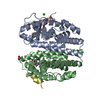 3erdS S: Starting model for refinement C: citing same article ( |
|---|---|
| Similar structure data |
- Links
Links
- Assembly
Assembly
| Deposited unit | 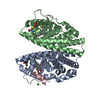
| ||||||||
|---|---|---|---|---|---|---|---|---|---|
| 1 |
| ||||||||
| 2 | 
| ||||||||
| Unit cell |
|
- Components
Components
| #1: Protein | Mass: 29908.256 Da / Num. of mol.: 2 / Fragment: ligand-binding domain (residues 297-554) Source method: isolated from a genetically manipulated source Source: (gene. exp.)  Homo sapiens (human) / Plasmid: pET23D / Production host: Homo sapiens (human) / Plasmid: pET23D / Production host:  #2: Protein/peptide | Mass: 1579.866 Da / Num. of mol.: 2 / Fragment: NR box II (residues 686-698) / Source method: obtained synthetically Details: The peptide was chemically synthesized. This sequence occurs naturally in mice. References: UniProt: Q61026 #3: Chemical | ChemComp-CL / | #4: Chemical | #5: Water | ChemComp-HOH / | |
|---|
-Experimental details
-Experiment
| Experiment | Method:  X-RAY DIFFRACTION / Number of used crystals: 1 X-RAY DIFFRACTION / Number of used crystals: 1 |
|---|
- Sample preparation
Sample preparation
| Crystal | Density Matthews: 1.96 Å3/Da / Density % sol: 43.48 % | |||||||||||||||||||||||||||||||||||
|---|---|---|---|---|---|---|---|---|---|---|---|---|---|---|---|---|---|---|---|---|---|---|---|---|---|---|---|---|---|---|---|---|---|---|---|---|
| Crystal grow | Temperature: 293 K / Method: vapor diffusion, hanging drop / pH: 8.8 Details: 16% (w/v) PEG 4000, 50 mM Magnesium chloride, 53 mM Tris pH 8.8 292-294 K, VAPOR DIFFUSION, HANGING DROP, temperature 293K | |||||||||||||||||||||||||||||||||||
| Crystal grow | *PLUS Temperature: 19-21 ℃ | |||||||||||||||||||||||||||||||||||
| Components of the solutions | *PLUS
|
-Data collection
| Diffraction | Mean temperature: 103 K |
|---|---|
| Diffraction source | Source:  SYNCHROTRON / Site: SYNCHROTRON / Site:  ALS ALS  / Beamline: 5.0.2 / Wavelength: 1.1 Å / Beamline: 5.0.2 / Wavelength: 1.1 Å |
| Detector | Type: ADSC QUANTUM 4 / Detector: CCD / Date: Oct 24, 1999 |
| Radiation | Monochromator: Double crystal / Protocol: SINGLE WAVELENGTH / Monochromatic (M) / Laue (L): M / Scattering type: x-ray |
| Radiation wavelength | Wavelength: 1.1 Å / Relative weight: 1 |
| Reflection | Resolution: 1.95→46.8 Å / Num. all: 34533 / Num. obs: 34533 / % possible obs: 97.9 % / Observed criterion σ(I): -3 / Redundancy: 3.5 % / Biso Wilson estimate: 25.2 Å2 / Rsym value: 0.065 / Net I/σ(I): 18.8 |
| Reflection shell | Resolution: 1.95→2.02 Å / Mean I/σ(I) obs: 2.9 / Num. unique all: 3432 / Rsym value: 0.531 / % possible all: 97.7 |
| Reflection | *PLUS Num. measured all: 119409 / Rmerge(I) obs: 0.065 |
| Reflection shell | *PLUS % possible obs: 97.7 % / Rmerge(I) obs: 0.531 |
- Processing
Processing
| Software |
| ||||||||||||||||||||||||||||||||||||
|---|---|---|---|---|---|---|---|---|---|---|---|---|---|---|---|---|---|---|---|---|---|---|---|---|---|---|---|---|---|---|---|---|---|---|---|---|---|
| Refinement | Method to determine structure:  MOLECULAR REPLACEMENT MOLECULAR REPLACEMENTStarting model: PDB ENTRY 3ERD Resolution: 1.95→46.8 Å / Rfactor Rfree error: 0.005 / Data cutoff high absF: 10000 / Isotropic thermal model: Restrained / Cross valid method: THROUGHOUT / σ(F): 0 / Stereochemistry target values: Engh & Huber
| ||||||||||||||||||||||||||||||||||||
| Solvent computation | Solvent model: flat model / Bsol: 61.9288 Å2 / ksol: 0.360796 e/Å3 | ||||||||||||||||||||||||||||||||||||
| Displacement parameters | Biso mean: 38.53 Å2
| ||||||||||||||||||||||||||||||||||||
| Refine analyze |
| ||||||||||||||||||||||||||||||||||||
| Refinement step | Cycle: LAST / Resolution: 1.95→46.8 Å
| ||||||||||||||||||||||||||||||||||||
| Refine LS restraints |
| ||||||||||||||||||||||||||||||||||||
| LS refinement shell | Resolution: 1.95→2.02 Å / Rfactor Rfree error: 0.024 / Total num. of bins used: 10
| ||||||||||||||||||||||||||||||||||||
| Xplor file |
| ||||||||||||||||||||||||||||||||||||
| Refinement | *PLUS Rfactor obs: 0.203 / Rfactor Rfree: 0.243 / Rfactor Rwork: 0.203 | ||||||||||||||||||||||||||||||||||||
| Solvent computation | *PLUS | ||||||||||||||||||||||||||||||||||||
| Displacement parameters | *PLUS | ||||||||||||||||||||||||||||||||||||
| Refine LS restraints | *PLUS
| ||||||||||||||||||||||||||||||||||||
| LS refinement shell | *PLUS Rfactor Rfree: 0.336 / Rfactor Rwork: 0.296 / Rfactor obs: 0.296 |
 Movie
Movie Controller
Controller


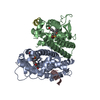
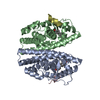
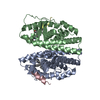
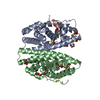
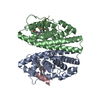
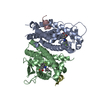
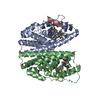

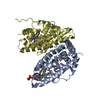

 PDBj
PDBj


















